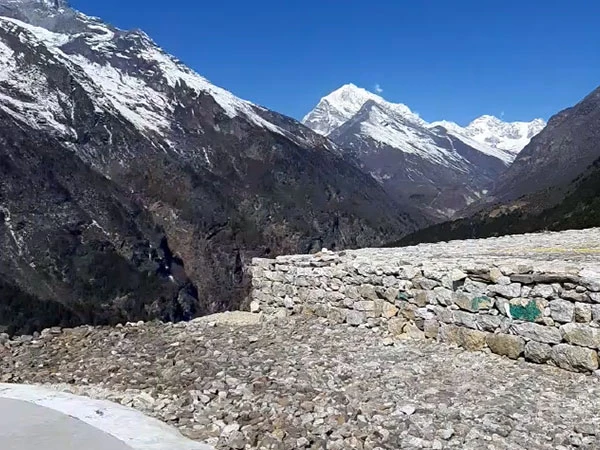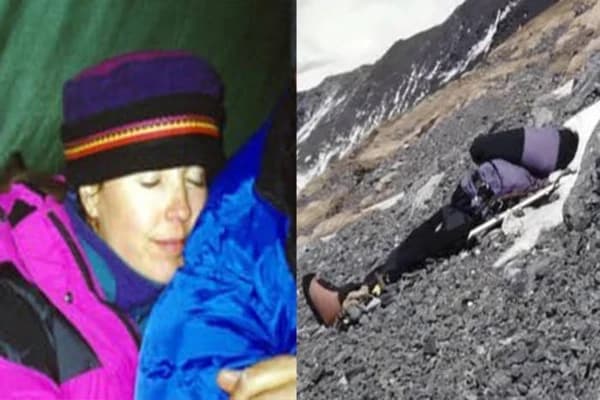The world is known for the number of emotional and sad stories of Everest climbers who were not able to make it successfully to their expedition. Their courage, passion, hardships and dedication are always reflected brightly through their last moment of their lives. Even as readers, when we hear or read about their story it gives us chills and feel sorry for what they had to go through on the top of the world.
Like every climber, they must have also dreamed of successfully summiting Everest, sharing their experience and making their loved ones feel proud but unfortunately, mother nature is brutal, unpredictable and fair, not sparing anyone from its damage. Scaling the highest snowy peak in the world definitely comes with life threatening challenges but the brave ones who believed in themselves and were ready to take the consequences were able to initiate this expedition. However not every brave climber can achieve the victory of a lifetime successfully.
“The green boots of Everest” is one of the most emotional and saddest incidents on Mount Everest. This is a story of a climber, later identified as Tsewang Paljor, an Indian member of the Indo-Tibetan Border Police expedition (ITBP) who couldn't make it to the journey successfully and perished within the main climbing route of the Everest.
About Tsewang Paljor “the Man Behind Green Boot”
Tsewang was one of those people who was brave enough to take on the challenges of Everest but unfortunate when it comes to achieving the victory of a lifetime on the top of the world. He was born on April 10th, 1968, in a small village of India called Shakti. He was always fond of mountains and landscapes so when he was involved in climbing profession wise, it really complimented his passion.
Before the Everest expedition, he climbed multiple peaks in his professional life of climbing as a ITBP. His job primarily focused on inspecting and protecting the 3488 km India - China on dangerous terrains of the altitudes. ITBP members are responsible for preventing any illegal border activities and ensuring safety of remote border areas and minimizing security threats.
So his hands were filled with responsibilities all while keeping up with the high altitude surroundings and challenging terrains. His position in the military profession was a head constable or sergeant as referred to in police forces in foreign countries. His profession comes with a lot of responsibilities and trust of the nation.
This very job allowed him to follow his passion and pursue effective training and experience which is important to reach the summit of Everest.
Also Read: Sleeping Beauty of Everest - Francys Arsentiev
What's the story behind “The Everest Green Boots Landmark”?
At the height of 8500 m, The corpse of a climber was found and regarded as a landmark on the infamous Northeast Ridge route of Everest for decades. The body was found curled up in the limestone alcove cave and a lot of climbers taking the Northeast ridge route encountered it on their way. The body was unidentifiable, but his bright Green Koflach Boots were very noticeable to passersby among numbers of fallen climbers on the slopes of the mountain.
This unidentified corpse became so noticeable among Everest climbers that they decided to name the cave he was located at as “The Green Boots Cave” and used it as a landmark on their route. This corpse of a fallen climber was left lying on the snow for almost 5 decades before he was finally retrieved in 2014.
Every Everest climber passing by was horrified by his lifeless body and how he ended up there. The gloomy ice cave with a mysterious identity of a green boots guy reminded people of the consequences that come with the dangers of climbing the world's highest peak. Despite feeling all the chills in the body at that high altitude, the climbers who passed through the cave performed a silent grieving ritual moment to acknowledge his ghostly presence and respect his value of life.
The green boots reminded Everest climbers of the fact that climbers, no matter how motivated and passionate about climbing, are bound to be vulnerable to the forces of nature. The beauty of Everest lures climbers through harsh ice-topped rocks, dramatic landscapes and terrains with blows of freezing cold wind but at the same time fuels their thirst for facing challenges and adventure in order to achieve their quest, proving their bravery and love for climbing among the world.
How did the Green Boots guy die on Everest?
Back in 1996, The Everest Expedition Indo-Tibetan Border Police formed a team to take risk and make the Indians visible and proud by summitting the Everest. The team included Head Constable Teswang Paljor, Leader Mahendra Singh, Deputy Leader Harbhajan Singh, Subedar Tsewang Samanla, Lansnayek Dorje Morpan and Commandant Mahendra Singh.
On the day of 10th May, at around 5:45 p.m. the Indian expedition team pushed for the summit. They were the first Indian Expedition team from the northern side to successfully reach the summit of the tallest mountain in the world and this achievement was celebrated along the camps on the mountain as well as in the capital city Delhi, India.
After their successful summit, they were headed to their descending route by Everest base Camp IV and were about to reach the pinnacle when suddenly they were faced with a vigorous cell of atmosphere that attacked the mountain out of nowhere. They lost visibility and started freezing due to the heavy storm. The horrific hurricane made it impossible for them to balance on the damp granite.
The commotion caused their team to split and lose contact with each other. Paljor and two of his mates were unable to descend to lower altitudes due to the extreme frigidity, hypothermia and lack of oxygen which ended with the death of all of the three climbers from their team. Since then the “unidentified” corpse of a fallen climber in the green mountaineering boots was resting in a cave. Despite the successful summit of Everest, the undougable tragedy hit the Indian Expedition team to the core.
All of the Everest climbers on that day, were faced with avalanches, blizzards and frostbites leading to the death of 8 climbers including Paljor, his 2 mates and injuring many. Their bodies were nowhere to be found. Some of the climbers ended up all over the slope and even trapped inside the death zone where they took their last breath and had a terrifying and lonely death. This marks one of the deadliest historical disasters on Mount Everest and received widespread publicity along with various controversies about the commercialization of Everest.
This is why the term “Green Boots” in the history of Everest summit climbers holds a deeply emotional story where many climbers lost their lives completely to achieve their dreams. Among roughly 200 corpses perished on Everest by the early 21st century, the unconscious body of Paljor with his pair of Green Boots reminded the climbers of that devastating incident every time they passed by for nearly 5 decades.
How did the “Green Boots” incident affect the Everest climbing community?
This tragic incident sparked a widespread discussion and analysis that resulted in radical transformation in the way excursions are executed at the highest peak of the world. The climbing community were aware that despite intense training, proper planning and preparation, it is impossible to tackle the might of Mother Nature and how life-threatening consequences need to be faced on their way to the top of the world.
People understood the unpredictable nature of mountains at higher altitudes does not spare anyone and humans are vulnerable against it. This incident also raised a lot of questions to the stakeholders who promote Everest climbing recklessly without considering its life threatening consequences. The trekking community raised the importance of concern regarding the favorable seasons for high-altitude trekking and need for experienced guides and Sherpas for more assistance and increased chance of reaching summit successfully.
The precious lives lost during this unforgettable and heartbreaking disaster contributed immensely to the trekking community and remained alive for the rest of the world in our hearts and memories. To this day, whenever we are reminded of the 1996 Mount Everest disaster, The story of Everest Green Boots and fallen climbers makes our heart feel heavy with sorrow.
What is the controversy regarding the Everest Green Boot guy?
The identity of a mysterious corpse located on the Northeast ridge route in a limestone cave named “Green Boots of Mount Everest” remained unidentified for a really long time. According to the senior Deputy leader of the ITBP Expedition team, The guy with the green boot was none other than “Dorje Morup”(One of the teammates of the ITBP Expedition who also lost his life in the 1996 Everest disaster and remained unable to be rescued. However he was later found lying under the shelter of a boulder close to camp VI by fellow climbers.)
An article written in 1997 on “The Indian accent of Qomolungma by the North Ridge” states that some Japanese climbers encountered Morup when he was unable to move or stand with severe frostbite, shortness of breathing and restlessness. His equipment was not functioning properly so the Japanese climbers offered some help and continued moving forward while Morup stayed behind.
Between first and second steps, Tsewang Paljor was witnessed by a sherpa from the Japanese climbing team when he was alive but struggling to move forward. Similarly the body of third teammate Tsewang Smanla was also recognized above the second step. Despite locating them in between those steps, struggling to make their way down, Morup and Paljor were never encountered alive again.
The encounterers believe that Morup might have passed away under a cave which is close to camp VI while taking shelter; recognizing his climbing gear and rucksack around him. And assumed that Paljor fell down the Kangshung Face and his body is nowhere to be found.
However, looking at the statistics, most of the research evidence regarding identification of this mysterious corpse shows that an Indian Mountaineer Tsewang Paljor is the one with the green boots.
Is the “Everest Green Boots” still there as a landmark on the Northeast Ridge Route of Everest way to summit ?
Although people believe that the body was retrieved and identified in 2014 according to reports as it was not visible to the climbers so they believe that it might have been removed or buried safely. However some climbers have reported that the unidentified climber with the green boots is still visible on their way to Everest as the same landmark.
This confusion might have been caused due to the changing surrounding of that landmark. Since more rocks and snow have piled up around the surrounding area of the body overtime in 2017.
To think that his body might still be on the way to Everest summit makes my heart heavy because I feel he deserves a much better place to rest in peace after everything he had to deal with given his circumstances. Not just Paljor, but everybody lying peacefully on the Rainbow Valley deserves a proper burial to rest forever peacefully even though the reality says otherwise.
Why are the dead bodies on Everest left behind?
On Everest everything is difficult !! Most significantly “the death zone” which is the section above 8,000 m creates very thin oxygen levels, definitely not enough to sustain a human life. In this case, supplementing the oxygens is the only solution which is also hard to acquire given the circumstances at that altitude. In the death zone, the body starts to deteriorate cell by cell every minute which weakens the body mentally and physically draining every ounce of energy in your body.
It is very risky to execute rescue missions on Everest. The frozen dead bodies on Everest weigh over 100 kg which requires multiple people to just retrieve one body, this just means inviting more risks for the rescuers. The harsh and unpredictable weather, weight and physical efforts required, difficult terrain, and the fortune it costs to recover bodies makes it very hard to retrieve the dead bodies on the Rainbow Valley of Mount Everest.
The climbers who come across dead climbers on Everest feel hopeless and question their ethical values when they don't have any option but to move forward and leave the dead ones behind. This isn't just about affording as well, it is about putting more lives on risk to save the fallen climbers.
The climbing community does not find it entirely bad to leave the fallen climbers on Everest since they dedicated their whole life to reach the top of the world. There are some climbers who prefer to lie on Everest for the rest of their lives as their final wish and give up to the face of nature. Some even consider it disrespectful or spiritually inappropriate by their loved ones or cultural values to remove their bodies from the lap of Everest.
So I guess it is very subjective when it comes to how people feel about leaving the fallen climbers on the Everest i.e. Rainbow Valley, an open graveyard to give a peaceful place for the dead ones to give much deserved rest.
Conclusion
The story of “Mount Everest Green Boot” is so much more than a tragic story into the dangerous slopes of Mount Everest. It reflects how the bravery, passion, motivation, hardships and dedication of humans is nothing when facing the unforgiving twist of Mother Nature.
Like Tsewang Paljor, all the climbers who embarked on this life threatening yet journey of a lifetime expedition had a dream to successfully reach to the top of the world with their brute spirit driven by courage and pride of nation hoping to make their loved ones proud and achieve a milestone. But Mother Nature is brutal, fair and unapologetic to everyone who comes across it playing with their body and soul to its every fiber, testing its limit.
Despite all of the successes and failures taking place in the same arena, Mount Everest will forever be iconic and continue to attract more adventurers and climbers from all the corners of the world and stand tall and strong in front of us. If we are putting ourselves in the hands of nature, then we better be ready for what it has to give in return. The scattered bodies in the Rainbow Valley represent the consequences of taking risks and underestimating nature.
Appreciating our human abilities, resilience, passion, skill and courage should go hand in hand to acknowledging the cost for reaching out to prove ourselves. The heartbreaking story of “Green Boots” and the unsolved questions it still has makes us realize how life-threatening are the risks of high altitude climbing and it calls for the need for responsible, professional, sustainable and respectful climbing culture all around the world.
Have any unanswered questions or confusions? Feel free to reach out to us on www.ammoniteadventure.com where we help you make smart travel decisions.
Happy Trekking!!!








